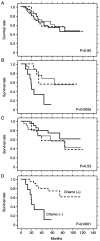Thymidylate synthase locus LOH in combination with genotype has prognostic and predictive significance in colorectal cancer
- PMID: 34650802
- PMCID: PMC8506693
- DOI: 10.3892/mco.2021.2398
Thymidylate synthase locus LOH in combination with genotype has prognostic and predictive significance in colorectal cancer
Abstract
The aim of the current study was to investigate the prognostic and predictive significance of polymorphisms in the thymidylate synthase (TS) gene, alongside the loss of heterozygocity (LOH) at this gene locus in patients with colorectal cancer. Genotyping was carried out for a variable number tandem repeat (VNTR) polymorphism in the TS 5'-untranslated region, a G/C single nucleotide polymorphism (SNP) located within this VNTR, and for TS LOH status in 246 colorectal cancer and paired normal DNA samples. The results were analyzed in relation to clinicopathological features, including the prognostic and predictive significance of TS genotype in patients who underwent curative surgery. Complete VNTR, SNP and LOH information for TS was obtained in 226 cases. No significant associations were observed between normal tissue TS genotype status and clinicopathological features. LOH of TS was observed in 58% of tumor samples and was associated with poor prognosis independently of clinical stage. Cases exhibiting TS LOH were classified into the three groups of 2R/loss, 3G/loss and 3C/loss. Patients with 3C/loss genotype status had poor outcomes when treated by surgery alone, but their survival was similar to patients with other genotypes following Fluorouracil (5-FU)-based adjuvant chemotherapy. The results suggested that LOH of the TS locus may be a significant prognostic factor in colorectal cancer, with the genotype of the residual allele also demonstrating an influence on prognosis. In conclusion, LOH status should be considered when TS genotype is explored as a potential prognostic and predictive marker for 5-FU-based adjuvant chemotherapy in colorectal cancer.
Keywords: 5-fluorouracil; colorectal cancer; genetic polymorphism; loss of heterozygocity; thymidylate synthase.
Copyright: © Kotake et al.
Conflict of interest statement
The authors declare that they have no competing interests.
Figures






Similar articles
-
Single nucleotide polymorphism in the 5' tandem repeat sequences of thymidylate synthase gene predicts for response to fluorouracil-based chemotherapy in advanced colorectal cancer patients.Int J Cancer. 2004 Dec 10;112(5):733-7. doi: 10.1002/ijc.20487. Int J Cancer. 2004. PMID: 15386371
-
Functional polymorphism of the thymidylate synthase gene in colorectal cancer accompanied by frequent loss of heterozygosity.Jpn J Cancer Res. 2002 Nov;93(11):1221-9. doi: 10.1111/j.1349-7006.2002.tb01227.x. Jpn J Cancer Res. 2002. PMID: 12460463 Free PMC article.
-
Prognostic significance of the polymorphisms in thymidylate synthase and methylenetetrahydrofolate reductase gene in lung cancer.Anticancer Res. 2005 Nov-Dec;25(6C):4455-61. Anticancer Res. 2005. PMID: 16334126
-
G>C SNP of thymidylate synthase with respect to colorectal cancer.Pharmacogenomics. 2007 Aug;8(8):985-96. doi: 10.2217/14622416.8.8.985. Pharmacogenomics. 2007. PMID: 17716232 Review.
-
Thymidylate synthase pharmacogenetics in colorectal cancer.Clin Colorectal Cancer. 2001 Nov;1(3):175-8; discussion 179-81. doi: 10.3816/CCC.2001.n.018. Clin Colorectal Cancer. 2001. PMID: 12450432 Review.
References
-
- NIH consensus conference. Adjuvant therapy for patients with colon and rectal cancer. JAMA. 1990;264:1444–1450. - PubMed
-
- Benson AB III, Schrag D, Somerfield MR, Cohen AM, Figueredo AT, Flynn PJ, Krzyzanowska MK, Maroun J, McAllister P, Van Cutsem E, et al. American Society of Clinical Oncology recommendations on adjuvant chemotherapy for stage II colon cancer. J Clin Oncol. 2004;22:3408–3419. doi: 10.1200/JCO.2004.05.063. - DOI - PubMed
-
- Schmoll HJ, Van Cutsem E, Stein A, Valentini V, Glimelius B, Haustermans K, Nordlinger B, van de Velde CJ, Balmana J, Regula J, et al. ESMO Consensus Guidelines for management of patients with colon and rectal cancer. a personalized approach to clinical decision making. Ann Oncol. 2012;23:2479–2516. doi: 10.1093/annonc/mds236. - DOI - PubMed
-
- Gill S, Loprinzi CL, Sargent DJ, Thomé SD, Alberts SR, Haller DG, Benedetti J, Francini G, Shepherd LE, Francois Seitz J, et al. Pooled analysis of fluorouracil-based adjuvant therapy for stage II and III colon cancer: Who benefits and by how much? J Clin Oncol. 2004;22:1797–1806. doi: 10.1200/JCO.2004.09.059. - DOI - PubMed
LinkOut - more resources
Full Text Sources
Miscellaneous
